How To Tell When Autoflower Is Flowering: Week-by-Week Grow
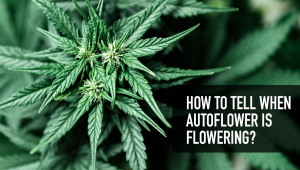
- 1. Intro
- 2. The vegetative stage of your cannabis plant
- 2. a. Week 1 - week 4: vegetative state
- 3. The pre-flowering stage
- 3. a. Week 5: the appearance of stigmas
- 3. b. How to recognize pre-flowers?
- 3. c. Autoflower not flowering?
- 4. The flowering stage
- 4. a. Week 6: stigmas in abundance
- 4. b. What are stigmas?
- 4. c. Week 7: development of trichomes
- 4. d. What are trichomes?
- 4. e. Week 8: calyxes fattening up
- 4. f. What are calyxes?
- 4. g. Week 9: harvesting time
- 5. How to tell if my auto is ready?
- 6. What to do once you have harvested your autoflower buds
- 6. a. Drying and trimming
- 6. b. Curing your buds
- 7. Expert opinion by jorge cervantes - co-author:
- 8. In conclusion
Preface
Cannabis cultivation is a topic of growing interest and importance in the agricultural and botanical worlds. Enzo Schillaci and Jorge Cervantes, two well-known experts in the cannabis industry, co-wrote this article, which offers a thorough guide on identifying the flowering stages of autoflowering cannabis plants from the vegetative stage to harvest time. The article covers critical topics such as the signs to look for in each stage, the proper nutrients to provide, and how to recognize pre-flowers and trichomes. It also delves into the scientific aspects of cannabis plants, explaining the functions of stigmas, calyxes, and trichomes and how to use these indicators to determine the optimal harvest time.
The article begins with an introduction to autoflowering cannabis plants and the differences between photosensitive and autoflowering plants. It then provides a week-by-week guide to the growth stages of autoflowering cannabis, from the vegetative stage to the pre-flowering and flowering stages, and finally to the harvesting time. Each stage is detailed, with accompanying images and explanations of the plant's structure and appearance changes. The article also provides practical advice on caring for the plants during each stage, including the appropriate nutrients to provide and techniques to apply.
Enzo Schillaci and Jorge Cervantes are well-known figures in the cannabis community, with extensive experience in cannabis cultivation and writing. Enzo Schillaci is a full-time cannabis writer at Fast Buds autoflowering genetics, originally from Argentina. He has traveled the world, gaining knowledge and experience in cannabis cultivation, and has been featured on various platforms. On the other hand, Jorge Cervantes has more than 40 years of experience writing books on cannabis cultivation. He is the author of "The Cannabis Encyclopedia" - a comprehensive guide to every aspect of cannabis cultivation.
Intro
If you’re new to growing autos, you may not know how these plants flower. Read along to know exactly what to look for, signs of pre-flowers, when the plants are in full bloom, and what to consider when growing autos.
For those who are new to growing autoflowering Cannabis plants, you may be unaware of exactly how these plants flower. As you may know, autoflowers start flowering automatically, without the need of changing the light cycle. Despite the minor differences between photos and autos, both will show the same signs when flowering such as white hairs, trichomes, and dense calyxes.
1. The Vegetative Stage of Your Cannabis Plant
Week 1 - Week 4: Vegetative State
Depending on the genetics you’re growing, there will be a growth period of around 4-5 weeks, during this time your cannabis plants will focus on developing green matter such as roots, branches, foliage, and establishing itself structure-wise prior to flowering. All of these parts of a plant are essential to cannabis because they’re used in vital processes such as transpiration which helps plants regulate the temperature and photosynthesis which is used to produce sugars used on plant growth.
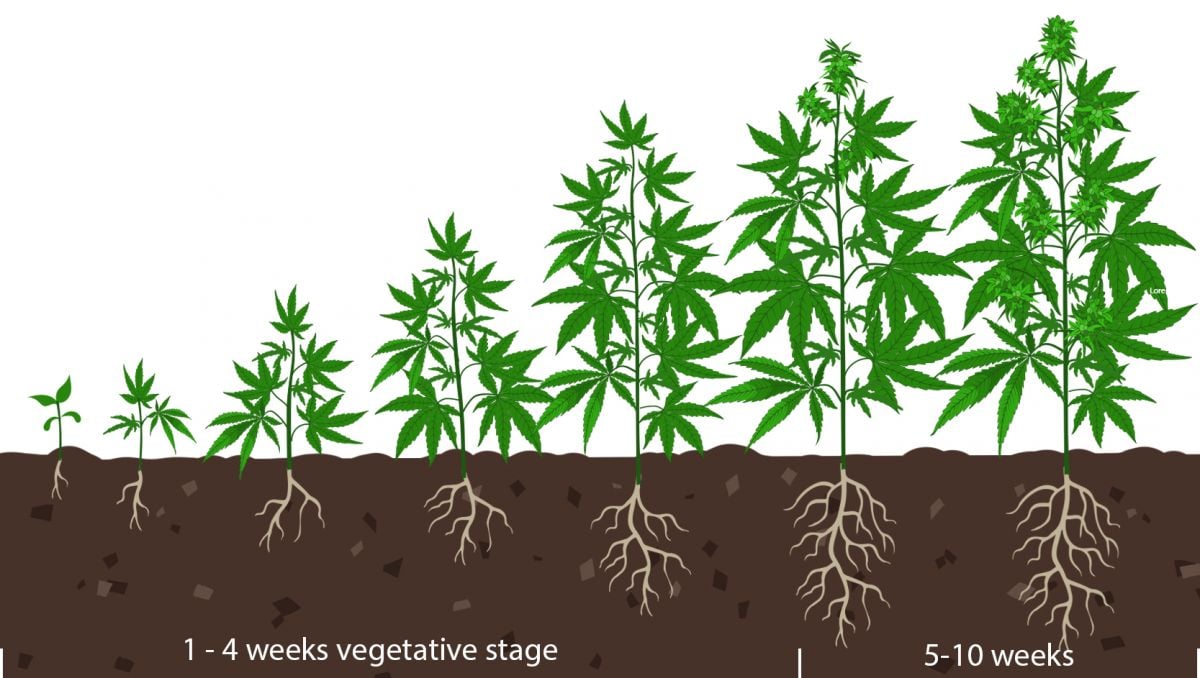
Also, all of this growth is what will allow your plant to withstand the weight of the buds during the flowering stage, as you may know, some plants produce super heavy flowers and if your plant hasn’t developed properly you’ll need to provide support or the branches may end up snapping. During this stage, there will be no signs of flowers and this is also the ideal window to apply plant training to your autoflowering plants.
- Focusing on stems, branches, and foliage development.
- Roots will grow and anchor into the growing medium.
- The ideal time to use techniques such as topping and L.S.T.
- Higher amounts of Nitrogen will be needed during this time.
2. The pre-flowering stage
Week 5: The appearance of stigmas
No matter what time of the year outside you decide to grow your autos, after the fourth week of growth the plants will begin to transition into the pre-flowering stage. This means they will shift in auxin production and focus on flowering causing a hormonal change and a preference for certain nutrients. When your plants start flowering you have to make sure that you're providing higher doses of phosphorus and potassium, these are the main minerals your cannabis plants need to produce buds.
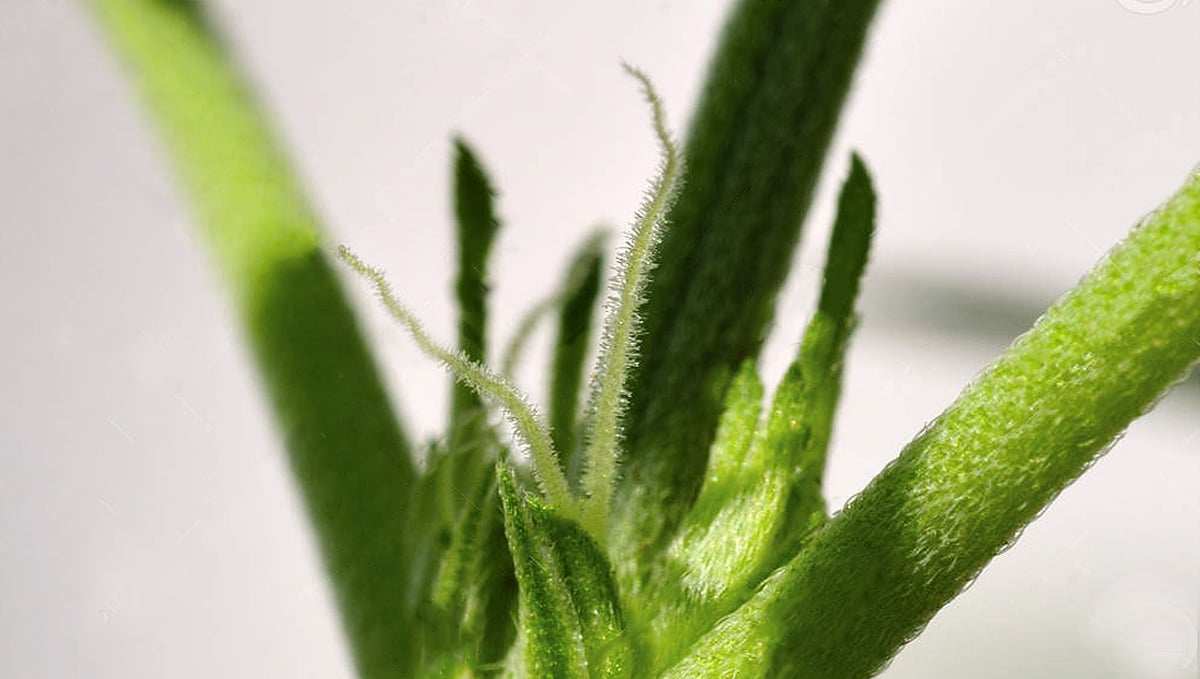
Apart from these two, cannabis plants also need micronutrients, these minerals are needed in much lower doses, and depending on the type of medium you're growing in, you will have to provide them with products such as CalMag additives. Other than Calcium and Magnesium, your plants also need Iron, Sulfur, Copper, and Zinc among others, and even though they are used in small quantities, your plant won't perform as well if they're not available so make sure they are.
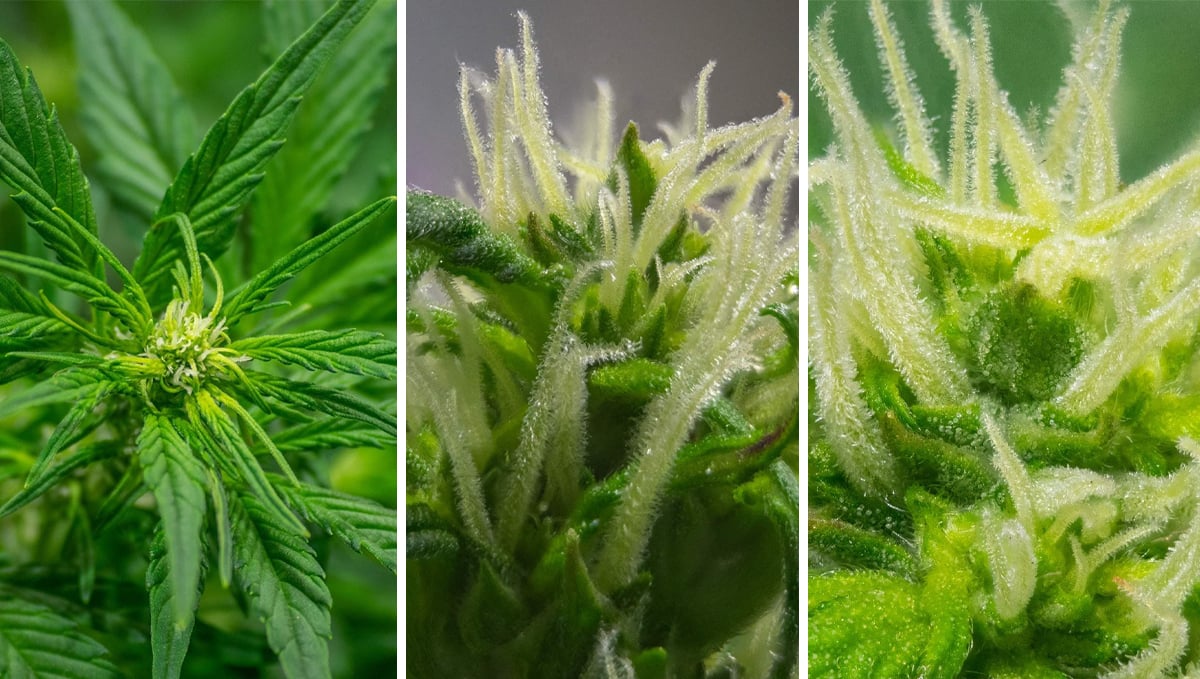
You can measure the amount of minerals present in your water source by using a TDS meter but you won't know exactly what's in it, so the only way to know exactly what's present is to filter your water and add the minerals to the desired quantity. It is from this point onwards that the plants will continue to fully bloom until the harvest date.
- Autoflowering plants will stop focusing on root development.
- The plants will go through a hormonal growth spurt causing them to stretch.
- Pre-flowers will appear in abundance very quickly after 4 weeks.
- Avoid training your plants at this point, especially topping.
- Plants will be more dependent on higher amounts of P-K now until harvest.
How To Recognize Pre-Flowers?
From the start of the pre-flowering stage until the end of your plant’s life cycle you’ll see an abundance of white hairs growing all over, these white hairs (stigmas) are a sign of a female cannabis plant. These long hairs emerge from the calyxes and are responsible for capturing pollen to produce seeds but usually, home growers don’t make seeds so these hairs won’t wilt and brown until the last couple of weeks of the flowering stage.
Autoflower Not Flowering?
As you may know by now, after 3-5 weeks your autoflower should be transitioning to the flowering stage but if the weeks go by and you don't see any signs of stigmas (white hairs) there are a couple of things that could be causing this. First of all, you need to remember that the information most breeders specify is when growing their genetics in optimal conditions so if you don't have a good light fixture, nutrients and are not controlling the conditions, your plants may take a bit longer but don't worry, they will flower.
Another factor that could have an influence is the phenotype you get, this happens because autoflowers are hybrids, which means they contain a mix of genetics, and the percentage of Indica, Sativa, and Ruderalis in each specific cultivar may vary so even if you are growing a strain that the breeder specifies it takes around 10 weeks, your plants could take a bit less (8-9 weeks) or a bit longer (11-12 weeks), depending on the phenotype and conditions provided.
3. The flowering stage
After your plant has already started showing signs of flowers, you’re officially in the flowering stage, even though your plant won’t grow more leaves or branches, she will still grow quite a bit through a process called “flowering stretch” and you will see the flowers getting denser as time goes by.
Week 6: Stigmas in abundance
The sixth week into flowering is when you’ll see your buds really starting to develop, at this stage your plant will start producing a lot of hairs and you’ll definitely see your plant full-on flowering.
As shown, the white hairs start super long and almost clear, and as time goes by they will brown and wilt, also looking shorter, this is because the calyxes which is where stigmas grow in are getting denser.
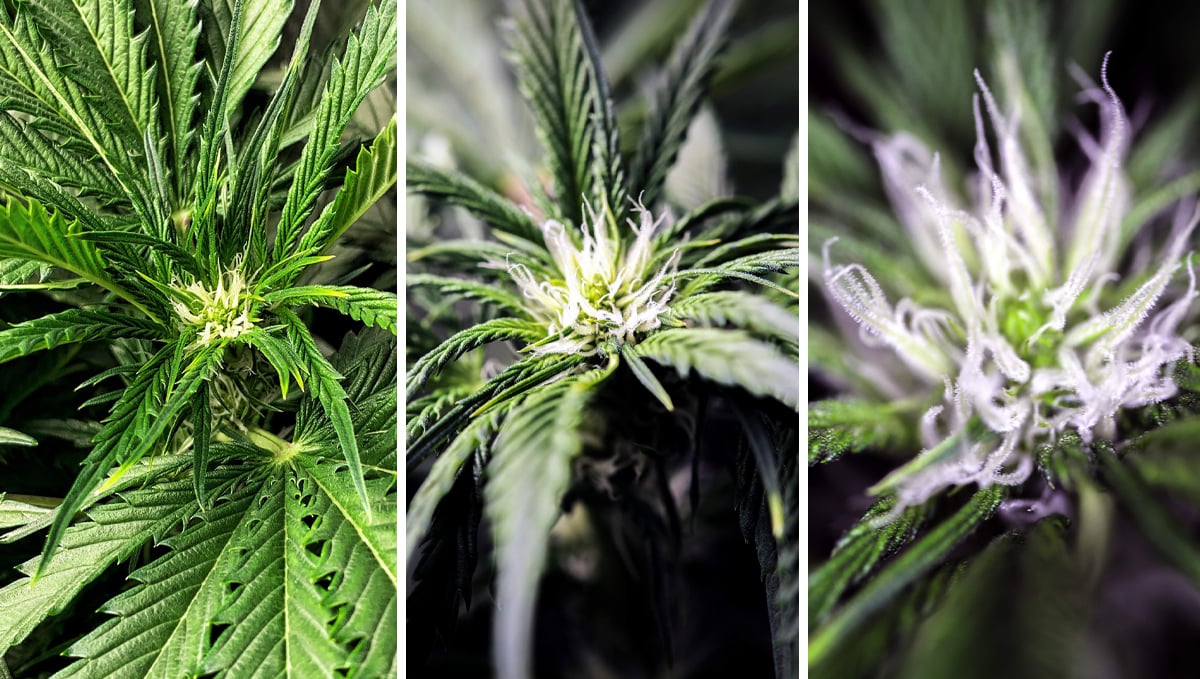
You will see a lot of hairs all over the flowering sites, these hairs are a sign that your plant is sexually mature and can now produce buds or seeds if it gets pollinated, you’ll also see the trichomes starting to appear with the stigmas, even though you won’t see a lot of resin right now because your plants have just started producing them, you will definitely be able to smell that sweet cannabis aroma.
What Are Stigmas?
Pre-flowers are the first signs of a female plant and the stigmas will start to appear, looking like small white, fuzzy hair. This is actually what ends up as the brown hair wrapped around your dried buds, and is the start of life for bud production.
Stigmas can be found on the flowering sites and as the plant develops, starting from the pre-flowering stage and onwards, the entire plant will become filled with thousands of long white hairs. The name of the white hair is stigma and will emerge from the calyxes. As the female sex organ, it is the stigma that must come into direct contact with the pollen in order to produce seeds.
Week 7: Development of trichomes
In the seventh week of flowering you will probably see an abundance of resin all over the buds and surrounding foliage, this is when you’ll definitely need a carbon filter or any other way to mask the strong cannabis aroma. In the image below you can clearly see a bit of resin starting to form although it is not as abundant as when the buds are ready for harvest, this is a sign that your plant has just transitioned from the vegetative stage to the flowering stage and will gradually start to fatten up the buds and producing a lot of resin.
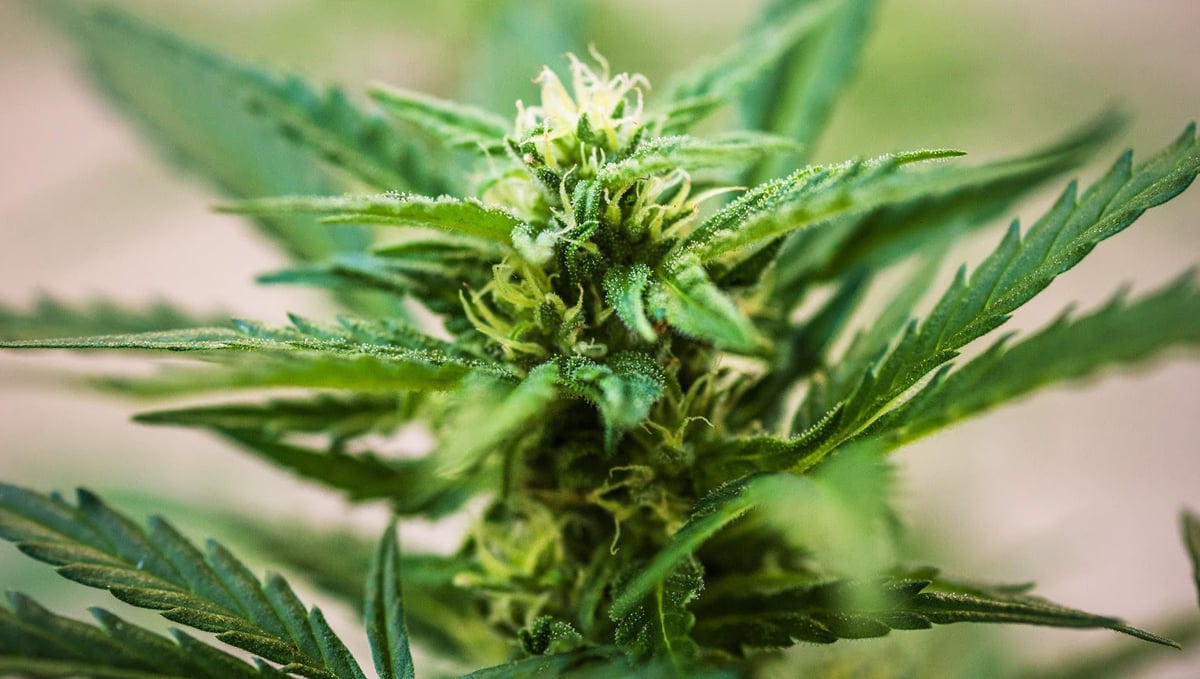
The trichomes produce and store all the sweet compounds you love so it’s essential you provide good conditions because the trichomes are volatile and can be degraded by physical contact, excessive heat, oxygen, and light. Remember that trichomes produce and store the terpenes which are responsible for the smell, in most cases, when cannabis plants start producing trichomes they will start smelling really strong so depending on where you’re growing and the setup, now it’s a good time to deal with it.
What are trichomes?
Trichomes form the resin you can clearly see on the buds and surrounding plant material, the trichome glands produce and store flavonoids, terpenes, and cannabinoids which are the compounds responsible for the effect, aroma, and flavor you’ll get when smoking your cannabis buds.
The trichomes are also responsible for protecting the buds against UV rays and bugs so if you see trichomes on your plant, it means the buds have already started developing or are right about to start. Let's dig a little deeper into exactly what trichomes are, and the different stages they go through as they develop.
What Are Trichomes Made of, And What is Their Primary Function?
The etymology of the word trichome comes from the Greek word for hair growth - trichōma - with the current definition being "delicate appendages on plants". They are found throughout the fauna world (as well as on algae and lichen) and come in a wide range of shapes and sizes. These growths usually come in the form of minuscule, mushroom-shaped appendages and can be made of hairs, glands, scales, and papillae. For most plants, the primary function of trichomes is the first line of defense against insects, pests, pathogens, and environmental stressors - This is done by the production of chemical compounds or through the physical structure of the trichome itself causing irritation.
The sting you receive when you brush up against a stinging nettle is caused by - you guessed it - the trusty old trichome. They can also perform a range of other functions, like leaf temperature regulation and boosting photosynthesis. There are even some plants that employ the use of trichomes in an offensive manner. such as the venus fly trap where the trichomes help the plant "grab hold" of the prey. Cannabis trichomes are purely defensive. They help with warding off any pests by releasing a sour, bitter flavor, and also help with protecting the plant against harmful UV rays and strong winds. They can even help with reducing the likelihood of fungal growth appearing. In terms of cannabis trichomes, there are a couple of different types that all go through a few stages of development.
Bulbous Trichomes
The smallest of the three types of glandular trichomes found on cannabis plants, and the only type that contains zero traces of cannabinoids, although they do produce low levels of terpenes. Measuring 15 - 30 micrometers, they are invisible to the naked eye and consist of only a few cells.
Capitate-Sessile Trichomes
Capitate-sessile trichomes are the mid-sized trichomes produced by weed plants and are the most plentiful. Tipping the scales at 25-100 micrometers, these can be viewed without a microscope, but only just and not always. They are found on the stems and leaves (but not the sugar leaves), and while they do contain cannabinoids and terpenes, they are much less potent than the third and final type of trichomes that weed plants produce.
Capitate-Stalked Trichomes
Capitate-stalked trichomes are the largest, and most important out of the three (for cultivators, anyway). Measuring a whopping 50-100 micrometers, this is the type of trichome we all think of when we hear the word. Covering the buds and sugar leaves (hopefully), this is where the majority of the cannabinoids and terpenes are produced. They comprise of a stalk and gland head, which holds all of that stick goodness we are trying to maximize.
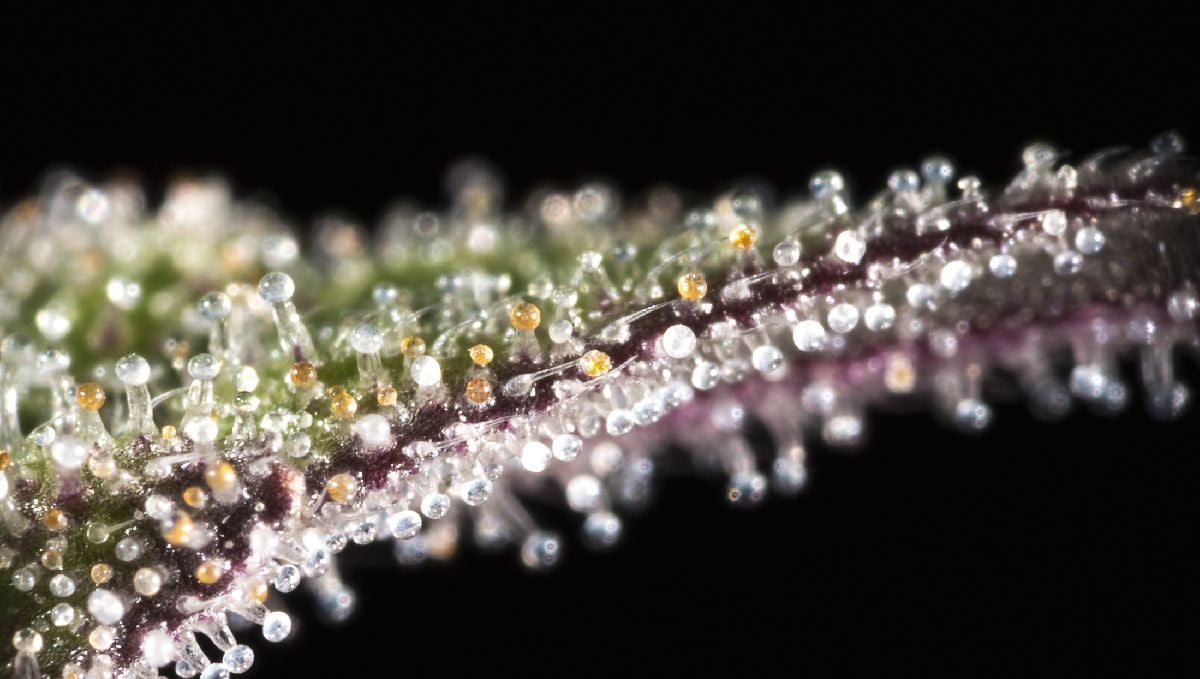
Trichome production begins when the plants enter the flowering stage of growth. As the calyxes begin to form, trichomes begin to cover the outer layer of the flowering head. Once the gland head has developed, compounds knowns as vacuoles and plastids are transported up the stalk where they begin to produce cannabinoids. The potency and abundance of cannabinoids are affected by both the plant genetics, and the environment it's grown in. The number of trichomes does not directly relate to the level of cannabinoids present, so you could have a bud that is absolutely dripping in resin that is actually of lower quality than a lightly dusted nug - the only way to really know is through lab testing. In general, crops grown under a wide spectrum of light will produce the highest potency, but again it really comes down to the genetics of the cultivar.
The lifecycle of a trichome runs in parallel to the lifecycle of the plant that produced it. Understanding this lifecycle is extremely important for cannabis cultivators, as it remains the gold standard way of timing the final chop. It's important to also understand that trichomes are volatile, and the point between peak maturation and the beginning of cannabinoid degradation is a small window. This is also strain-specific, which is one of the reasons behind why many growers, especially large-scale cultivators like to focus on a small number of strains and really get a deep understanding of each. Trichomes go through three distinct stages in their lifecycle:
- Clear Trichomes - This is the first stage of trichome maturation, and when the plant is still producing peak levels of both cannabinoids and terpenes. This is the stage where the trichome head is slowly filling with all the stuff that we want, so it's not recommended to harvest your crop while most of the trichomes are translucent, or clear. Crops harvested with a larger percentage of clear trichomes will offer a more Sativa-like effect.
- Cloudy Trichomes - Sometimes also referred to as "milky", this is the point when potency has reached its peak for both cannabinoids and terpenes. Some cultivators like to harvest their crop when the majority of trichomes are at this stage (say 90% cloudy), but again, this is strain-dependent.
- Amber Trichomes - When trichomes turn amber, it is an indication that some of the cannabinoids have started the degradation process. It is at this stage that the trichomes will offer a more classic Indica effect, with some growers preferring to let a good percentage of the trichomes mature to the amber stage to enhance this heavy high.
So, when is the recommended time to harvest based on the state of the trichomes? The go-to rule of thumb is to harvest when there is a 70/30 split between cloudy and amber trichomes. But keep in mind, you may want to harvest at a slightly different time depending on the strain and the effect you are looking for. If you prefer a Sativa, cerebral high, then you should harvest a little earlier. If you prefer the more couch-lock style effect, then you can wait until there is a 50/50 split between cloudy and amber trichomes.
Week 8: Calyxes fattening up
Week 8 into flowering is the week before the last, your buds will be relatively denser and will give you an idea of how they will turn out after harvesting, another good way to know if your plant is flowering is when the calyxes become plump. As you can see in the image below, even though the plant still needs a couple of days, the calyxes are super fat and round, meaning this plant won’t fatten a lot more but isn’t completely mature yet.

When the calyxes have become plump and are visibly dense, it means your plant is almost ready to be harvested, it just needs a bit longer to ripen and you’ll be all set. This happens because the calyxes are what protect the seeds which is how cannabis plants guarantee their next generation so if a plant has not been germinated and the calyxes are round and plump, it means the reproduction phase has ended and your plants are ready to finish their life cycle.
What are calyxes?
The calyxes are the first part that is formed when a cannabis plant enters the flowering stage, this structure is designed for protecting the plant’s reproductive organs and is where the stigmas come out.
Even though both male and female plants have calyxes, only the female plants are what matters to most home growers because the calyxes are what form the flowers you’ll end up smoking.
Week 9: Harvesting time
In the last week of flowering, you’ll see the stigmas wilting and browning, when this happens, it’s a sign that the buds are ripening and it will only take a couple of days to be chopped down.
When your plants have completely matured and the stigmas have turned brown, your plant won’t take more than just a couple of days to be completely mature, at this stage you’re just waiting on the state of the trichomes to harvest your buds at the right time.
3. How to tell if my auto is ready?
The pistils, trichomes, and calyxes are signs that the plants are close to harvesting and the trichome development is fully or almost fully mature. Now just because the hairs have turned brown does not mean you should grab your trimming scissors and eagerly get to work, however, there are a few other things you should check:
1. The stigmas have completely turned brown and wilted, this means your plants have already gone through the reproduction stage and are almost nearing the end of their life cycle.
2. The calyx has fully bulged, becoming as swollen as possible giving the buds a compact appearance. It is better to wait for the buds to be as fat as they can be before harvesting, even if all the hairs are and the trichomes are fully matured.
3. Use a high-powered lens and examine the state of your trichomes. You will notice the head of the trichome will be either clear, milky, silver, or amber-colored. Harvesting your autoflowering plants when the trichomes are milky to amber will provide better effects.
| Best time to harvest based on the trichomes | |
|---|---|
| State of the trichomes | Effect |
| Clear | Still unripe, not too potent. |
| Cloudy | At their peak potency. |
| Amber | THC degraded into CBN, more corporal effect. |
Remember that you don't need to follow this table but it may be of help, by knowing exactly what effect each state of the trichomes provides you can fine-tune your harvest when your plants will provide the desired effect, so for example, you don't want a super-strong head rush, you can harvest when 50/50 of the trichomes are amber and cloudy, resulting in a more balanced effect.
5. What to Do Once You Have Harvested Your Autoflower Buds
Ok, so you have gone through the painstaking process of growing your autoflowering crop. You have made it all the way through and harvested the flowers at the perfect time (when the trichomes are displaying a 50/50 ratio of cloudy and amber).
This means it’s time to smoke up, right? Wrong!
Honestly, you have only won half the war! Seems crazy right? Depending on the style of cultivation, you may have had months of hard toil to get to this point, but there are still some key processes to be followed if you really want to get the best out of the harvest and all the hard work you have put into it. Although cannabinoid and terpene production has ended, the maturation of both is anywhere but over.
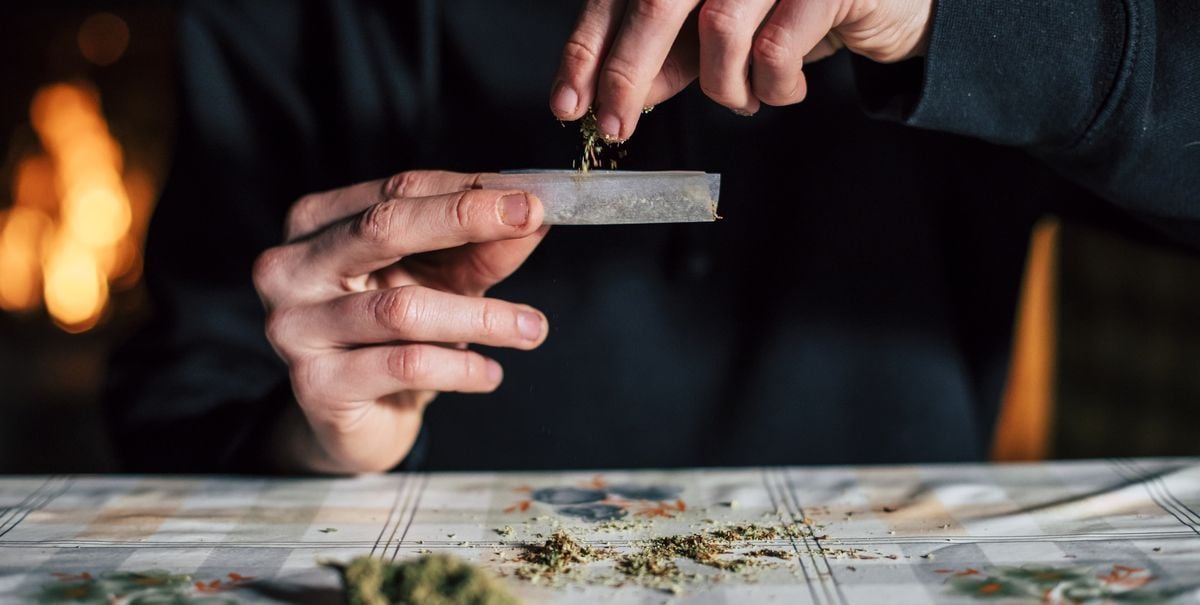
Sure, you could throw the oven on the lowest setting and put some of the buds in to quickly dry them off. And we would be straight-up liars if we said we hadn’t committed said crime in our past. But, if you have something else on hand to smoke and are not totally desperate then wait on! Let’s have a quick chat about how you should go about drying, trimming, and curing those hard-earned buds.
Drying and Trimming
The first decision you have to make is whether to dry or wet trim the harvest. In almost all circumstances we recommend dry trimming. Only wet trim if you live in a particularly hot and humid climate, and you are unable to control the environment in the dry room. Any trimming is a laborious and sticky job, but wet trimming is much messier and can affect the overall quality of the smoke in a harmful way, so if you can, dry the weed first then trim it. You want the buds to dry slowly over a period of 8 to 14 days. To achieve this, it is very important to have environmental control over any drying room or area. You want the ambient temps to be at 60 - 70 F (15 to 22 C), and the relative humidity must be between 55-65%.
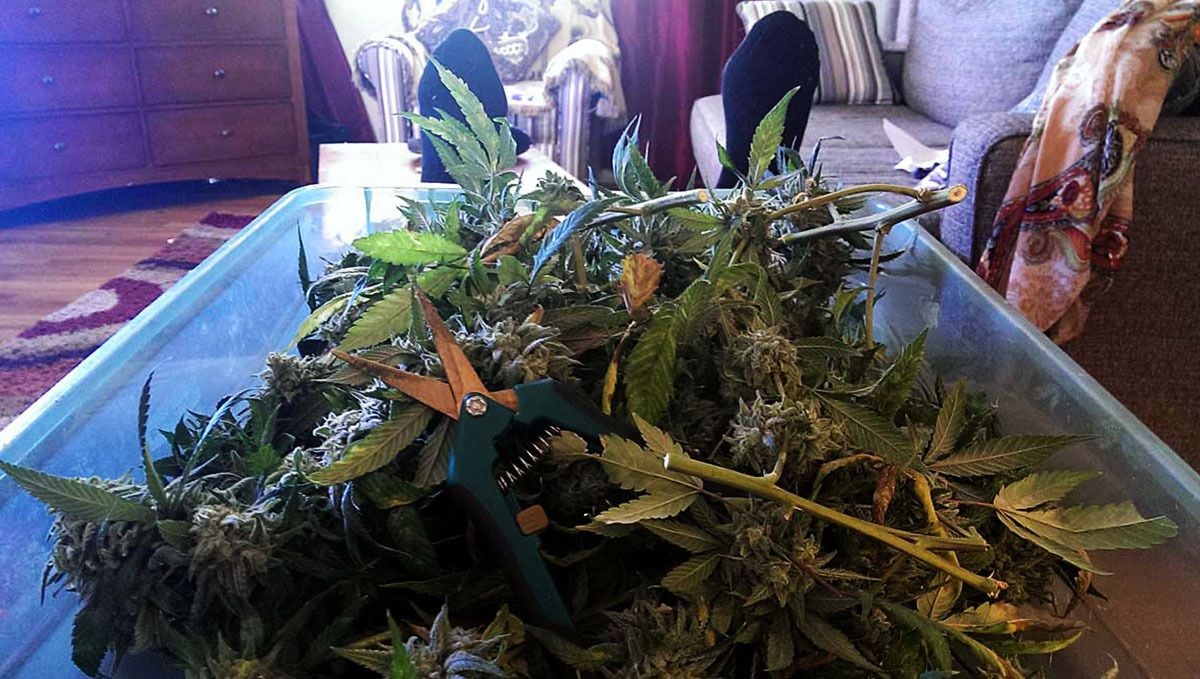
You also need to make sure that the drying area is as dark as possible. Sunlight is a cannabinoid and terpene killer, so keep them in pure darkness if you can. You may have hit the drying lottery and live in the perfect climatic conditions, but for most of us, that is just not the case. If that is not the case, then you most likely going to need some pieces of kit to help you keep the temps and humidity in the right range. You should already own at least one hygrometer (that’s a temp and humidity gauge). Grab that and check where the levels are at. If the ranges are incorrect you may need to grab a humidifier (or dehumidifier), an AC unit, some fans, or a heater. Use whatever is needed to keep the temps and humidity within the required ranges. Just remember to never have any of the fans, the AC unit, or the heater pointed directly at the drying buds, as this can have a hugely negative effect on the overall quality.
Once the buds are nicely dried it’s time to trim. Grab some good trimming scissors off amazon or from your local hydro store (do not use household scissors unless you want max pain) and a trim tray. These two pieces of kit will make your trimming experience much more enjoyable.
Curing Your Buds
Now it’s time to smoke, right? Ummm, well kind of….For sure, at this point, the buds are in a good condition to smoke. But, if you want to get the best out of your crop you have to let it cure! Think of curing like aging for wine or whiskey. Depending on the strain, it can take anywhere between 2 weeks to 6 months for the terpene profile to fully mature - but in most cases, a curing time of one month will be perfect. Go out and grab some re-sealable mason jars (or any airtight container really). Place the buds inside without overfilling the jars, 75% full is perfect. The flowers need the space to breathe here.
For the first 10 days, you are going to want to burp the jars twice a day. Don’t worry if your buds seem a little moister, to begin with. This is to be expected as the internal moisture leaks out to the exterior bud layer. After the first 10 days, the jars only need to be burped twice a week or so. After a month you should have some of the highest quality weed you have ever seen, as curing is an overlooked part of the process - especially for commercial growers.
EXPERT OPINION BY JORGE CERVANTES - CO-AUTHOR:
Understanding the scientific principles and fundamentals of cannabis cultivation is essential for preventing potential issues and achieving a successful harvest. This article provides valuable insights into the growth stages of autoflowering cannabis plants, explaining the key indicators to look for and the appropriate care to provide at each stage. It is essential to understand the functions of stigmas, calyxes, and trichomes, as these are essential indicators of the plant's health and maturity. Providing the proper nutrients at the right time is crucial for the plant's development and harvest quality.
Promoting organic growing practices, sustainable and responsible cultivation, and sharing knowledge are fundamental principles I have advocated for in my 40+ years of writing about cannabis cultivation. It is essential to adopt these practices to ensure the long-term success and viability of the cannabis industry. My extensive body of work aims to empower the next generation of cannabis growers, advocate for cannabis legalization and education, and contribute to the enduring legacy of the cannabis community.
As the cannabis industry continues to evolve, it is essential to heed the guidance of experts and adopt sustainable and responsible cultivation practices. This article provides valuable insights and practical advice for growers of autoflowering cannabis plants, contributing to the knowledge base and fostering a community of informed and responsible growers.
6. In Conclusion
It is very important when growing autoflowering cultivars to know what to look for, as well as what to feed them. Once you have achieved the perfect balance in the feeding department. Getting familiar with different cultivars can take time and experience. The diversity of autoflowering Cannabis is at its pinnacle, with so many hybrids with a wide variety of different traits.
Good luck growing your autos this year and we hope this article will help you on your way to growing some incredible crops!
External References:
- TRICHOMES OF CANNABIS SATIVA L. (CANNABACEAE) - Dayanandan, P. & Kaufman, Peter. (1976).
- Pollen-Pistil Interaction and Fertilization. - Shivanna, K. (2020).








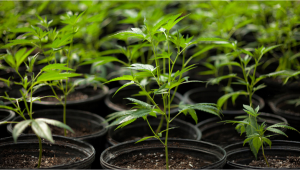
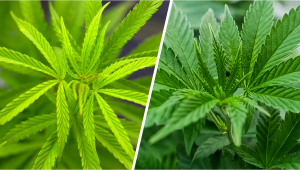
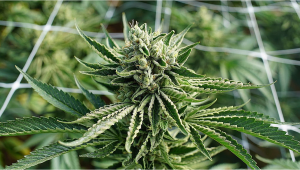

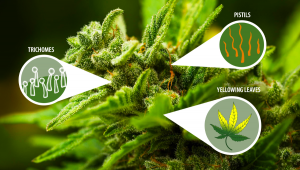
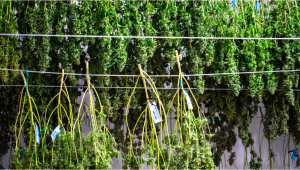


Comments